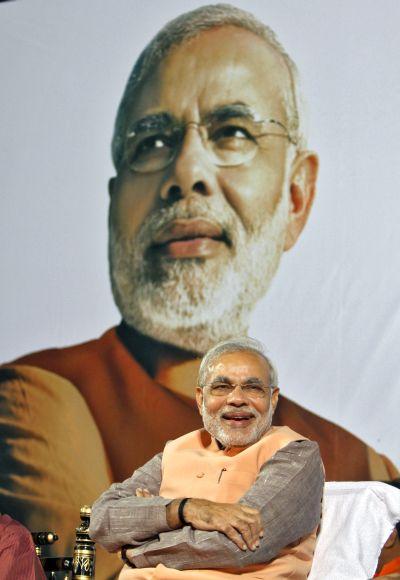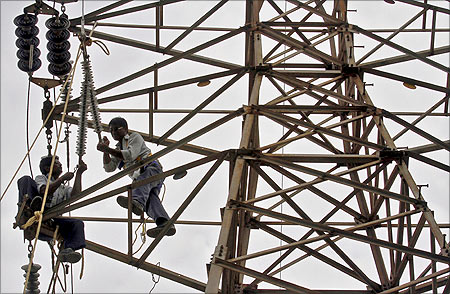 | « Back to article | Print this article |
Did Modi make Gujarat Vibrant?
What has been so impressive about Gujarat has been its balanced growth. It was not led by either services, manufacturing or the agriculture sector alone, notes Mayank Mishra.
Gujarat Chief Minister Narendra Modi’s supporters -- whether inside the Bharatiya Janata Party, out on the streets or in cyber space, are fond of saying Modi’s Gujarat is the best thing that has happened to the country in a long time.
To support their claim, they offer explanations like annual 10-plus per cent growth in the past 10 years, stellar performance by the agriculture sector, improved power scenario, good infrastructure and a robust investment pipeline, thanks to successive Vibrant Gujarat summits.
But what do the numbers say?
Has Gujarat witnessed a paradigm shift after Narendra Modi became chief minister of the state in late 2001?
How has Modi’s Gujarat performed vis-a-vis other states in the period? Have the benefits of growth percolated down?
Click NEXT to read further. . .
Did Modi make Gujarat Vibrant?
How much?
Gujarat did record an impressive average annual growth rate of 10.08 per cent between 2004-05 and 2011-12.
In fact, 2005-06 was a record year, with a growth rate of nearly 15 per cent.
However, Maharashtra had 10.75 per cent, Tamil Nadu 10.27 per cent and Bihar showed 11.42 per cent in the same period.
While Bihar had the low base advantage, Maharashtra and Tamil Nadu have been developed states for a long time.
What has been so impressive about Gujarat, however, has been its balanced growth.
It was not led by either services, manufacturing or the agriculture sector alone.
Each of the three segments contributed significantly, says Sunil Parekh, an Ahmedabad-based industrial advisor, associated with many Gujarat-based companies.
Gujarat’s performance in agriculture has been impressive.
According to Planning Commission data, agriculture and allied sectors showed annual growth of 6.47 per cent.
Yes, this was less than Maharashtra’s 7.74 per cent and Bihar’s 15.17 per cent from 2005-06 to 2011-12.
However, Gujarat’s growth was on the back of 5.65 per cent growth from 1996-07 to 2004-05.
During this period, Maharashtra grew a meagre 2.64 per cent annually; Bihar grew 6.76 per cent.
Click NEXT to read further. . .
Did Modi make Gujarat Vibrant?
Reasons
Agricultural growth in Gujarat has been primarily driven by three factors -- adoption of Bt (genetically modified) cotton, emphasis on minor irrigation and construction of check dams -- says Anil Gupta, professor at the Indian Institute of Management, Ahmedabad. What has helped is a great deal of innovation in small machinery related to the farm sector.
There are nearly 10,000 small machineries, which have helped improve farm productivity, he says.
The adoption of new irrigation techniques not only increased the productivity but helped farmers save on electricity.
The state’s Green Revolution Company offers a subsidy to farmers to adopt this technique.
About 500,000 hectares has been covered under the scheme.
Another innovation has been in construction of check dams.
Nearly 150,000 have been built in the past 10 years.
The cumulative effort has resulted in the percentage of net irrigated area going up from 31.4 per cent in 2000-01 to 44.71 per cent in 2006-07.
Farm productivity saw a sharp increase, as a result.
The productivity of cereals has risen nearly 100 per cent and of cotton by nearly 200 per cent since 2000.
Click NEXT to read further. . .
Did Modi make Gujarat Vibrant?
Then there is the Sardar Sarovar dam that became fully functional from 2001.
There is an associated canal network of 75,000 km, irrigating nearly 1.8 mn ha in Gujarat.
Gujarat has turned a food surplus state from a food deficit one in the past 10 years.
Wheat production has gone up from eight mn tonnes to 40 mt and the state produces nearly 40 per cent of the country’s cotton, says Jay Narayan Vyas, a former Cabinet minister.
The government has also made substantial progress in power generation and distribution in these 10 years.
Total installed power capacity was nearly 9,000 Mw in 2003-04 and this was 23,887 Mw by March 2013.
Equally impressive has been the record on cutting transmission and distribution losses, down from 35 per cent to a modest 15 per cent in the period.
Gujarat, as a result, is one of the few power surplus states.
Click NEXT to read further. . .
Did Modi make Gujarat Vibrant?
Other factors
It is not that Gujarat is growing only now.
In fact, the state registered an annual growth rate of 12.9 per cent from 1992 to 1997. This dipped in the IX Plan period (1997-2002) and picked up again during the X Plan and subsequent years.
Sociologist Dipankar Gupta says Modi has looked after what he inherited from successive governments till 2001.
Gujarat was always at the number 3 spot and it stays there.
Except for about 170 villages, all others were electrified before Modi; true of most roads and ports, soda ash production and refineries as well.
It must, however, be said he did not squander his inheritance but did well to develop on it as earlier chief ministers had done.
The biennial Vibrant Gujarat summit from 2003 has added value to Brand Gujarat, say commentators.
Click NEXT to read further. . .
Did Modi make Gujarat Vibrant?
The first edition saw the signing of 76 memoranda of understanding, worth Rs 66,000 crore (Rs 660 billion).
The fifth edition in 2011 saw the signing of 8,380 MoUs, with investment proposals worth nearly Rs 21 lakh crore (Rs 21 trillion).
However, only a small percentage of the proposals at the summit get translated on the ground.
The conversion rate is nearly 20 per cent.
This depends on so many factors, says Parekh.
What attracts investors to the state is its infrastructure and business-friendly environment, say commentators.
Gujarat has about 40 ports, handling 20 per cent of the country’s cargo movement.
It is a power surplus state and its road infrastructure is such that it takes less than a day to move goods to any port from anywhere in the state, says Parekh.
Urban infrastructure will get a further boost from development of twin cities such as Ahmedabad-Gandhinagar and Surat-Bharuch, he adds.
Sound financial health of most of the urban local bodies is another reason why urban infrastructure is better than in many states, adds Anil Gupta.
Click NEXT to read further. . .
Did Modi make Gujarat Vibrant?
Issues
The growth numbers have been impressive.
Have the benefits percolated down?
Have small and marginal farmers reaped the benefits of accelerated agriculture growth?
What is the basis of the observation made by a scholar associated with the Anand-based Institute of Rural Management that the state has been good for industry, good for the middle class but not so good for the deprived section?
These are the issues in debate.
THE MODI JOURNEY
- September 1950: Born in Vadnagar, a town in Gujarat’s Mehsana district;
- 1958: Started going to RSS shakhas;
- 1970: Became an RSS pracharak;
- 1987: Formally joined BJP;
- 1988: General secretary of party’s Gujarat unit;
- 1990: In charge of Gujarat leg of LK Advani’s Somnath to Ayodhya ‘rath yatra’;
- 1991: In charge of party president Murli Manohar Joshi’s ‘ekta yatra’;
- 1995: BJP national secretary;
- 1998: National general secretary;
- 2001, October 7: Sworn in as Gujarat chief minister;
- 2002, end-February: Gujarat pogrom begins, goes on for weeks;
- 2002, December: Sweeping re-election win in assembly polls;
- 2007, December: Modi govt again re-elected in assembly polls;
- 2008, October: Modi persuades Ratan Tata to move Tata Nano plant to Sanand, near Ahmedabad;
- 2012, December: Wins third term for party in state assembly polls.







